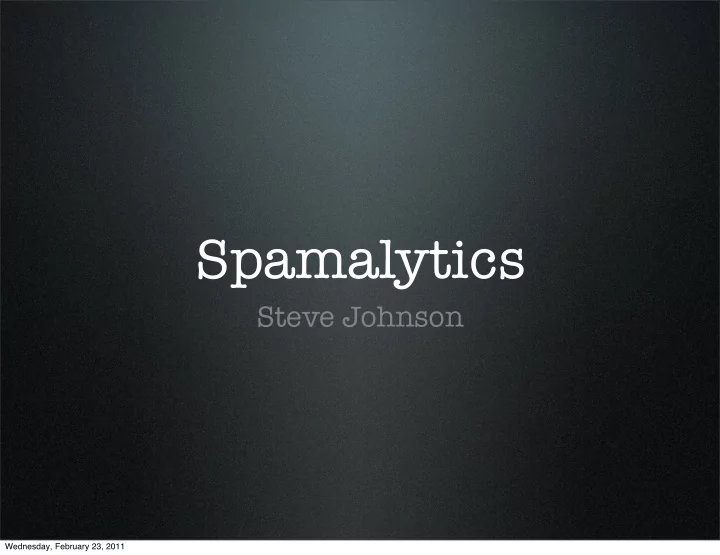

Spamalytics Steve Johnson Wednesday, February 23, 2011
Introduction • What percentage of people click on spam? • How profitable is spam? • Answer these questions for a better understanding of how to stop spam • But how to answer them? Wednesday, February 23, 2011
Overall Methodology • Temporarily take control of part of the Storm botnet • Send through spam, but change URLs to point to their own servers • Analyze results using data from web sites, botnet workers Wednesday, February 23, 2011
Economics of Spam • Junk mail costs about $250-1000 per thousand to send with a conversion rate of 2.15% • Ease of sending email begat spam on a huge scale, and a spam arms race • Spam costs ??? per thousand with a conversion rate of ??? • Filling in ???s may help us win the arms race using economics Wednesday, February 23, 2011
The Storm Botnet Wednesday, February 23, 2011
Storm: Connecting • Populate “bootstrap list” from parent, from random IDs, and from found peers • Connect to peers • Publicize self to peers Wednesday, February 23, 2011
Storm: Storing/Finding • DHT interface • Time-based “rendezvous code” to find each other. One for yesterday, today, and tomorrow. • Combine date with random integer 0-31 for 32 total keys per day • Used to rendezvous with C&C nodes, which publish their IP+port for others to find and connect to Wednesday, February 23, 2011
Storm: Spamming (2) Emails: stephen.r.johnson@case.edu, barbara.snyder@case.edu, misha@case.edu Subject: {adj} {synonym_for_viagra} for you Body: Two {pills} of {synonym_for_viagra} 10.99{!!!} {url} (4) stephen.r.johnson: success barbara.snyder: success misha: failure Wednesday, February 23, 2011
Invading Storm • Allow virtual machines to be infected and elevated to proxy status • Route bot traffic through a gateway which rewrites URLs and blocks DDOS requests • Now the workers are spamming with the researchers’ URLs which they can analyze hits to Wednesday, February 23, 2011
Measuring Delivery • Ability to pass filters measured by setting up test email accounts and inserting the addresses into jobs • Remove them from results to hide them from real Storm controllers • Some extra email received there due to dictionary bots, “leakage” in Storm Wednesday, February 23, 2011
Measuring Conversion • URLs in dictionary rewritten to be researcher-controlled URLs with unique IDs appended • Focus on two types of campaigns: self- propagation and pharmaceuticals • Pharmaceutical campaigns point to affiliate web sites • Self-propagation campaigns use executables disguised as greeting cards, April Fools jokes Wednesday, February 23, 2011
Measuring Conversion • To mimic pharmaceutical sites, entire sites cloned except for 404 instead of payment page • To mimic self-propagation, replace Storm executable with program to send a single HTTP POST to researchers’ servers and then quit (to confirm execution of program) Wednesday, February 23, 2011
Behavior of Crawlers • Access URL with no unique identifier • Access robots.txt • Disable Javascript and images • IPs that access with multiple User- Agents • Downloads executable 10+ times • Add honeypot IPs to dictionaries that are not sent in spam Wednesday, February 23, 2011
Ethics • Strictly reduces harm • Neuters spam messages • Proxies do not pass through harmful jobs • Proxies themselves do not participate in spam campaigns Wednesday, February 23, 2011
Experimental Results Wednesday, February 23, 2011
Workers and Spam • 78% of workers connected to researchers’ proxies once, 92% at most twice, 99% at most 5 times • 81% connected to only a single proxy, 12% to two, 3% to four, 4% to 5+ • Self-propagation campaign dictionaries ~92% unique addresses • Pharma dicts ~60% unique Wednesday, February 23, 2011
Conversion Rates Wednesday, February 23, 2011
Crawlers, Time to View • 87% of page views were from crawlers • 10% of viewing IPs were crawlers Wednesday, February 23, 2011
Effects of Blacklisting Wednesday, February 23, 2011
Extrapolation • Authors make huge disclaimers about all analysis based on sample size • 28 “sales” for 350,000,000 emails over 26 days • Average sale price ~$100, so about $140/day • Researchers controlled 1.5% of proxies, so real revenue probably about $7,000 Wednesday, February 23, 2011
Extrapolation • Yearly revenue $3.5M, split 50/50 with affiliates is $1.75M • “Retail” price of spam delivery $80/M, so $25,000 to send 350M emails which is not cost-effective • Conclusion: Storm controllers are spammers themselves • Therefore, spammers must be vertically integrated Wednesday, February 23, 2011
Issues and Questions • Lots of extrapolation based on small sample size and anecdotes, even with disclaimers • Ethics • If they can detect other researchers, can the botnet controllers detect them? • How much data needed for statistical significance? Wednesday, February 23, 2011
More Questions • Do you think the reasoning for their extrapolations is fair? • How representative of spam is their sample? Wednesday, February 23, 2011
Geography of Conversions Wednesday, February 23, 2011
Recommend
More recommend